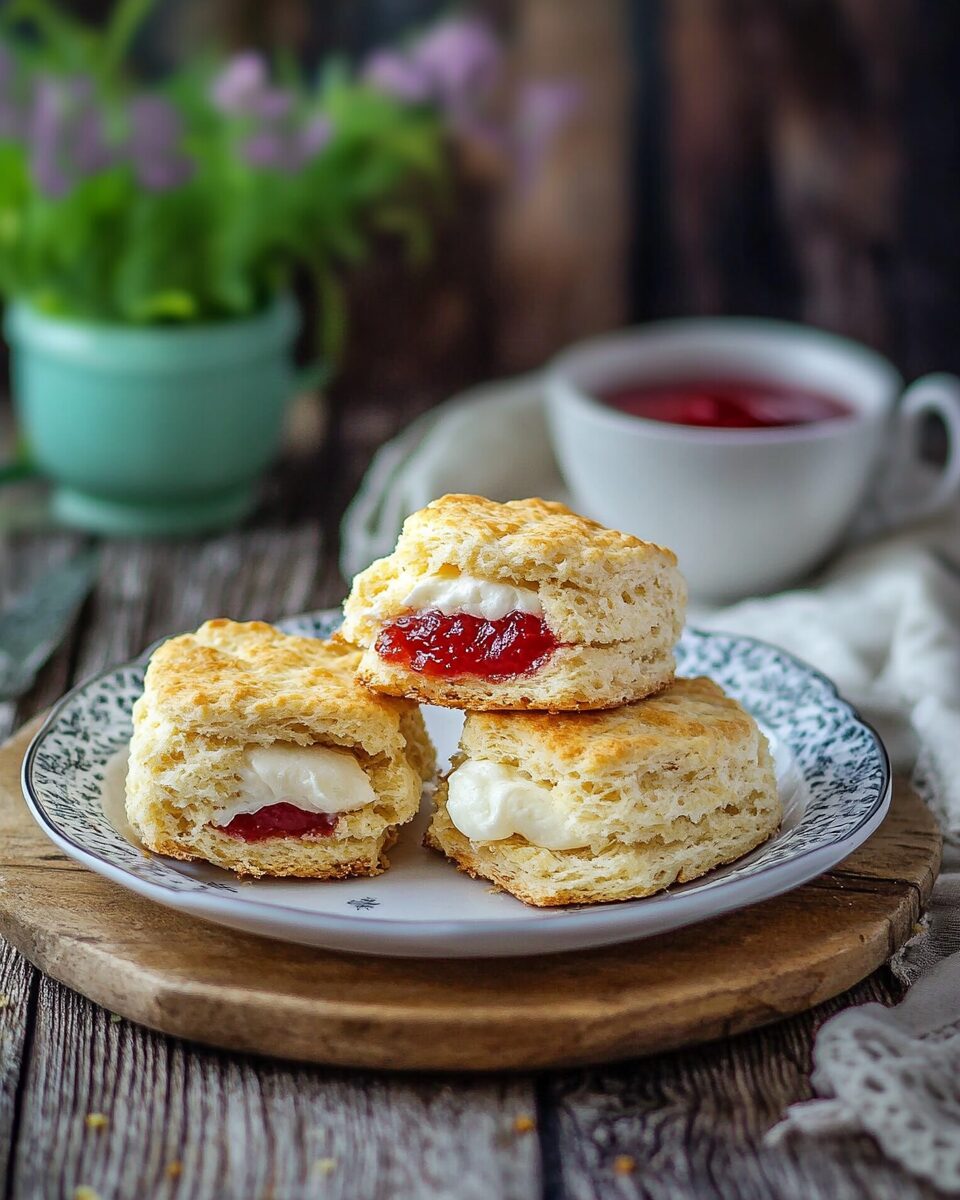As an Irish chef, I’ve crafted the Best-Ever Irish Scones recipe to bring you an authentic taste of Ireland. These scones feature a crunchy, crackly exterior with a moist, dense interior, and a lightly sweet flavor. Perfect for breakfast or a delightful snack, they pair wonderfully with butter, jam, or cream.
FULL RECIPE:
Ingredients
- 3½ cups (16 oz/497 g) all-purpose flour
- 5 teaspoons baking powder, leveled
- Generous pinch of salt
- ¼ cup (2 oz/60 g) sugar
- ¼ cup (2½ oz/71 g) cold, cubed, salted butter
- 1 egg
- ¼ cup (2 fl oz/57 ml) double cream
- ¾ cup (6 fl oz/170 ml) whole milk
- Milk for glazing
Directions
- Preheat Oven: Set your oven to 350°F (180°C).
- Mix Dry Ingredients: In a large bowl, combine the flour, baking powder, salt, and sugar.
- Incorporate Butter: Add the cold, cubed butter to the dry ingredients. Using your fingers, rub the butter into the flour mixture until it resembles coarse breadcrumbs.
- Combine Wet Ingredients: In a separate bowl, whisk together the egg, double cream, and whole milk until well combined.
- Form the Dough: Pour the wet mixture into the dry ingredients. Gently mix until a soft dough forms, being careful not to overmix.
- Shape and Cut: Transfer the dough onto a floured surface. Lightly knead and then roll it out to approximately 1-inch thickness. Using a round cutter, cut out scones and place them on a parchment-lined baking tray.
- Glaze: Brush the tops of the scones with a little milk to achieve a golden finish.
- Bake: Bake in the preheated oven for 35 minutes, or until the scones are golden brown and sound hollow when tapped on the bottom.
- Cool and Serve: Once baked, remove from the oven and allow the scones to cool on a wire rack. Serve warm or at room temperature with your choice of accompaniments.
Nutrients Facts (Per Serving – 1 Scone)
- Calories: 376
- Calories from Fat: 108
- Total Fat: 12g (18% Daily Value)
- Saturated Fat: 8g (50%)
- Polyunsaturated Fat: 1g
- Monounsaturated Fat: 3g
- Cholesterol: 56mg (19%)
- Sodium: 400mg (17%)
- Potassium: 200mg (6%)
- Total Carbohydrates: 55g (18%)
- Dietary Fiber: 2g (8%)
- Sugars: 10g
- Protein: 7g (14%)
History and Significance of Irish Scones
Irish scones have been a staple in traditional Irish cuisine for centuries. Unlike the sweeter and softer American-style scones, Irish scones are known for their slightly dense yet crumbly texture and rich, buttery flavor. Historically, scones were made using simple ingredients readily available in Irish households, such as flour, butter, and milk. They were commonly baked on a griddle or open hearth before modern ovens became widespread. Scones became popular in Ireland due to the country’s strong dairy industry, which provided an abundance of high-quality butter, cream, and milk, key ingredients in achieving the perfect scone texture.
What Makes This Irish Scone Recipe Special?
This Best-Ever Irish Scone recipe stands out due to its authenticity and perfect balance of ingredients. Unlike overly sweet or overly dry scones, these have a light sweetness, rich buttery notes, and a perfect rise that creates a soft yet flaky texture. The key elements that make this recipe exceptional include:
- Proper Use of Butter: Cold, cubed butter is rubbed into the flour mixture to create a crumbly dough that results in a flaky, tender scone.
- Balanced Sweetness: Unlike American scones, which tend to be heavily sweetened, Irish scones have a mild sweetness that allows them to be paired with both sweet and savory toppings.
- The Right Baking Temperature: Baking at 350°F ensures the scones rise evenly, creating a beautifully golden crust while keeping the inside moist and soft.
- Traditional Method: This recipe follows the classic Irish baking technique of mixing the wet and dry ingredients gently to avoid overworking the dough, which can lead to tough scones.
Serving Suggestions and Pairings
Irish scones are incredibly versatile and can be served in a variety of ways depending on the occasion. Here are some popular ways to enjoy them:
- Classic Butter and Jam: One of the most traditional ways to eat Irish scones is with a generous spread of butter and homemade fruit jam. Strawberry or raspberry jam pairs exceptionally well with the buttery flavor of the scones.
- Clotted Cream and Honey: For a more luxurious treat, pair your scones with clotted cream and a drizzle of honey. This combination is particularly popular during afternoon tea.
- Savory Twist: If you prefer a less sweet version, serve the scones with cream cheese, smoked salmon, or sharp cheddar cheese. The buttery flavor of the scones complements savory ingredients beautifully.
- Tea or Coffee Pairing: Irish scones are traditionally served with a hot cup of tea, but they also go well with freshly brewed coffee. A strong black tea, such as Irish Breakfast Tea, enhances the richness of the scones.
Tips for Making the Perfect Irish Scones
To achieve the best results when making Irish scones, follow these expert tips:
- Use Cold Ingredients: Cold butter, milk, and cream help create the ideal flaky texture. If the butter starts to melt while handling the dough, chill the dough for a few minutes before rolling it out.
- Do Not Overmix the Dough: Overworking the dough will develop gluten, resulting in dense scones instead of light and tender ones. Mix the ingredients until they just come together.
- Use a Sharp Cutter: When cutting out scones, use a sharp-edged cutter and press straight down without twisting. Twisting the cutter can seal the edges, preventing the scones from rising properly.
- Bake Immediately After Shaping: Letting the shaped dough sit for too long before baking can affect the rise. For best results, pop them into the oven as soon as they are ready.
- Brush with Milk for a Golden Finish: Brushing the tops with a little milk before baking gives the scones a beautifully golden color.
Common Mistakes to Avoid
Even experienced bakers can sometimes run into issues when making scones. Here are some common mistakes and how to fix them:
- Using Warm Butter: If the butter is too soft or melted, the scones will lose their flakiness. Always use cold butter and work quickly.
- Adding Too Much Liquid: Excess liquid will make the dough too sticky and difficult to handle. Measure the ingredients carefully to maintain the right dough consistency.
- Rolling the Dough Too Thin: Scones should be at least 1 inch thick before cutting to ensure a proper rise.
- Overbaking: Leaving the scones in the oven for too long will dry them out. Keep an eye on them and remove them once they are golden brown and firm to the touch.
How to Store and Reheat Irish Scones
Freshly baked scones taste best on the day they are made, but you can store leftovers properly to maintain their texture and flavor.
- Room Temperature Storage: Store scones in an airtight container at room temperature for up to two days. Keep them away from direct sunlight and moisture to prevent them from drying out.
- Refrigeration: If you need to store them for a longer period, refrigerate them in an airtight container for up to five days. However, refrigeration may slightly alter the texture, making them less tender.
- Freezing: Irish scones freeze well. Wrap each scone in plastic wrap, place them in a freezer-safe bag, and freeze for up to three months. To reheat, bake them at 300°F for about 10 minutes or microwave for 20-30 seconds.
- Reheating: To restore the original texture, warm the scones in the oven rather than the microwave. Microwaving may make them soft, while a quick oven reheat will bring back the crisp exterior.
Variations of the Classic Irish Scone
While the traditional Irish scone recipe is simple and timeless, you can experiment with different flavors to suit your preferences:
- Fruit Scones: Add raisins, currants, or dried cranberries to the dough for a naturally sweet twist.
- Cheese Scones: Mix shredded cheddar or parmesan into the dough for a savory version that pairs well with soups and stews.
- Chocolate Chip Scones: For a sweeter treat, fold in chocolate chips and serve warm with whipped cream.
- Herb Scones: Incorporate fresh herbs like rosemary or thyme for a fragrant, savory scone that complements hearty meals.
Conclusion
Irish scones are a beloved part of traditional Irish baking, offering a delicious and satisfying treat that can be enjoyed at any time of the day. Whether you prefer them sweet or savory, these scones are versatile and easy to customize with your favorite flavors. The Best-Ever Irish Scones recipe captures the essence of classic Irish baking, providing a perfect balance of texture and flavor. By following the expert tips, avoiding common mistakes, and experimenting with variations, you can make the most delightful scones that will impress family and friends.






